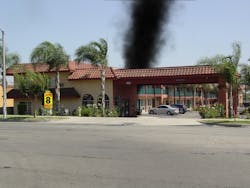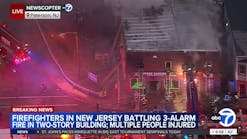In the October 2017 edition of Firehouse Magazine, we looked at the first half of the strategy and tactics acronym SLAB SAVERS. The SLAB portion looked at profiling the structure to help you determine if it was to be an offensive or defensive operation. These items included the Safety Profile, Life Profile, Air Track and the Building Profile to focus on risk vs. gain. If you determine that the structure warrants an offensive operation, then we are going to be SAVERS of life and property using sound tactics.
With that in mind, in this next portion of SLAB SAVERS, we will cover deploying the tactics using the SAVERS acronym:
- Search/Rescue
- Attack
- Ventilation
- Exposures/Extension
- Rapid Intervention
- Salvage
The acronym
I am sure you are already thinking, “Oh great, another acronym.” I understand. I grew up in the fire service with acronyms, and I use quite a few of them. However, I also like acronyms that make sense to me and how I do things.
As a young firefighter, I learned both RECEO and REVAS, but neither of these acronyms aligned with how I look at commanding a fire, and both came to fruition before the concept of rapid intervention. I can assure you that I am not saying that those acronyms are not great tools. I love Lloyd Laymen and have read his book “Firefighting Tactics” many times. However, as an incident commander (IC), the last three letters in the RECEO acronym (Confine, Extinguish, Overhaul) are all part of fire attack. In many organizations, I hear the IC tell a crew conducting fire attack that their objectives are to confine, extinguish and overhaul the fire.
The other thing that this acronym does for me is that each one of these items can go from the task level to the tactical level by adding a group level supervisor if you have multiple resources assigned to that function. I will use the terminology of Initiate, Assume or Assign based on the “Calm The Chaos” training program by Chief Anthony Kastros. At the task level, the first company will commonly be assigned to initiate a task. They are not a division or group as of yet, as they are only one resource.
“Engine 1, enter through the Alpha side to initiate fire attack.”
There could also be other objectives that go along with this, but it is based on what that single resource can do. As the incident grows, if another resource is assigned to fire attack, then the tactical level would be implemented or Fire Attack Group. The second resource (Engine 5) into the immediate danger to life and health (IDLH) can either assume the fire attack group or they can be assigned to the original resource and then Engine 1 would assume the group level. I personally prefer the first method as that first company officer in the area is already embedded at the task level. The second company officer has the ability to get new information as they come in and stay of the immediate IDLH area to have better control and situational awareness.
“Engine 5, take an additional line into the Alpha side. Complete a primary search and check for extension. You will be assuming the fire attack group and will have Engine 1 working for you.
Another option: “Engine 5, bring an additional line through the Alpha side for primary search and extension checks. You will be assigned to Engine 1 which will be fire attack group.”
You could also send Engine 5 in to report to Engine 1 (Fire Attack) without any objectives because they would be given objectives by the group supervisor. It also requires full circle communication to all those involved so they know who they are working for or who is working for them. “Engine 1, I am assigning Engine 5 to you with an additional hose line.”
Either way, the company assigned should be getting tasks or objectives to be completed. In management, it is common to hear it as giving SMART (Specific, Measurable, Attainable, Realistic and Time) objectives. In the command world, I teach the acronym ACT (Action, Commander’s Intent, and Time).
The action is obviously what you want accomplished. The commander’s intent is giving it a purpose or describing the end state. The time is either a measurement of time or a benchmark completed.
Let’s now delve into the specific parts of the SAVERS acronym.
Search/rescue (evacuation)
All life safety hazards will fall into this category, but they are not the same. Search, rescue and evacuation all have certain definitions and objectives. Search is defined as just that, looking for unknown victims or possible victims, and known victims with unknown locations. This is accomplished through primary and secondary searches utilizing different companies. In today’s modern fire environment with more fuel, rapid fire spread, smoke conditions and building construction, it is even more imperative to conduct a primary search as soon as possible.
A single engine company should not be assigned the objective of fire attack and to conduct a search in certain buildings. In fact, these may be two tasks that you should consider not combining. Within the SLAB SAVERS training program, they are usually distinctly separated. If we are honest with ourselves, if an engine company is given both of those assignments, even in a residential fire, then one of those will probably not be getting done (or done well). The only way that this crew usually finds a victim is if they trip over it on the way to the fire.
One of the options to get a company inside doing a primary search quicker is by using the two-out crew. Once a company arrives to become the rapid-intervention crew (RIC) and the fireground tasks associated with the two-out function are transferred, then the two-out crew is ready to make entry to perform the search.
Rescue is different from search with the verification of the occupant. This can change a few aspects just by definition. First off, this becomes a known rescue so it should change your risk vs. gain profile. Based on the location of the occupant, you may need to adjust your entry point, search pattern, rescue techniques being deployed and exit strategy. There may also be attributes of the victim that will change how you conduct your search and rescue. What is their age? Children will bring special search and rescue factors, as will the elderly, handicapped or developmentally disabled.
Evacuation is assisting victims who are not in the IDLH area. This can be in a large structure or multi-story building. This does not necessarily require fire department personnel to conduct evacuation. Use other resources, such as building staff, law enforcement, ambulance personnel or volunteer forces.
Attack
The first thing to discuss in the fire attack element is just that—getting water on the fire. In the modern fire behavior environment, fire attack is the #1 priority if you want to save lives and property. It will increase the survivability of your victims and decrease our risk when it comes to the other tactics, such as ventilation, protecting exposures and rapid intervention.
We also need to remember the tactic of confinement. This goes beyond transitional attack and exterior door control. Door control must also be used on interior doors. As mentioned previously, if fire attack and search operations are separated, then the crews can also control interior flow paths, causing less damage (fire, smoke and water) and protecting victims. We can also use steam conversion if the fire and room involved allow.
Ventilation
If we go back to the main objectives of ventilation, it becomes easier to decide when, where and how we ventilate. The tactic of ventilation is to aid in confining the fire, aiding in fire attack by reducing heat and assisting with search by creating better visibility.
Your ventilation tasks should also be based on the SLAB risk assessment:
- Safety Profile: Is it safe to put a crew on the roof? Can we mitigate the hazards?
- Life Profile: Is there a savable life inside the structure? If so, where do we ventilate to facilitate rescue.
- Air Track: This is obviously a big factor that must be taken into consideration when ventilating.
- Building Profile: What type of ventilation can be conducted? Many times, the building may be the deciding factor on whether to ventilate.
Extension/exposures
The “E” in the SAVERS acronym can be used for either Extension or Exposures—or both. Extension is internal, and exposures are external. Depending on the fire, you may end up with an engine company checking for extension in an adjoining unit while another is doing exposure protection on an adjacent building. Both tasks can also be expanded into groups if needed.
As mentioned in the attack portion of this article, if you extinguish the main portion of the fire, then it helps to mitigate these tasks. You must use enough water to overcome the fire or you will never be able to keep the fire from spreading to other portions of the building or defend the exposures. However you break it up, the goal is to keep the fire as small as possible. If one room is involved, try to keep it to one room. If one building is involved, try to keep it to just one, and so on.
Rapid intervention
As we continue to break down the tactics, we need to put some emphasis on managing the Rapid Intervention function. We spend quite a bit of time teaching firefighters how to save themselves and rescue the firefighter down, but we must continue to conduct training on managing the mayday too.
We already use acronyms for the firefighter who is in trouble, such as LUNAR and GRAB LIVES. For rapid intervention command, I use RESCUE:
- Rapid intervention crew activation
- Establish additional radio frequencies
- Start additional resources (ambulance, medical helicopter, heavy rescue, etc.)
- Call for a personal accountability report (PAR)
- Update objectives (based on a firefighter in trouble)
- Ensure notifications are made (chaplain, chief, OSHA, family, etc.)
Possibly the hardest decision that we may have to make on this incident is to not send in the RIC based on conditions or reports from the crews. Any IC who has had to make this decision has been criticized, ostracized and persecuted. You can use the previous SLAB acronym to determine if the RIC will be going interior based on one of our own being inside with protective equipment and SCBA. I hope that we never need to make this decision.
Salvage
Going back to the priority of saving lives and property leads us to salvage. During our salvage operations, we are trying to save the property from damage incurred by fire, smoke and water. Many fire departments are beginning to take the door control concept inside the house and closing doors to other rooms inside the house as fast as possible to prevent damage to the valuables. The fire attack crew makes entry and closes doors as they advance toward the fire area. As the additional crew comes in to perform search, they will also close the door behind them while they search the room, much like the Vent, Enter, Isolate, Search (VEIS) tactic. If the fire attack crew did not initially see a victim in their hasty search toward the fire area, then closing the doors also increases survivability for the victim.
The other property damage that must be considered during salvage is firefighter damage. Firefighters should be taught ways to open walls, ceilings and roofs that are conducive to making repairs easier and less costly. We should also not be “breaking” more than we need to. Use tools that can assist with limiting damage, such as thermal imaging cameras, salvage covers, hall runners and small mop-up hoselines, if possible. Use forcible-entry techniques that limit damage if time allows.
Salvage may be a lost art in some fire departments and we need to train our crews to bring it back. Saving the family pictures or the financial documents for a business can go a long way.
Scenarios
Next we will look at the six scenarios presented in Part 1 or this article, this time from a SAVERS point of view. We will also be showing you how to use this system to expand into a larger incident and how it applies to a tactical worksheet in either paper or digital formats. To watch details videos of these simulations that walk through each of the SAVERS steps using the stop light approach, visit slabsavers.com/Fire-Simulations.html.
Scenario 1 will look at a fire in a two-story motel and cover the basics of utilizing the system as well as the difference between using divisions and groups. It will break down the condition report and discuss the SLAB profile regarding this occupancy.
Scenario 2 has us responding to a residential structure fire with a reported explosion. Upon our arrival, we find an immediate exposure problem and a possible patient.
Scenario 3 will address a fire in a large commercial occupancy with a warehouse area as well as offices. This scenario will focus on building construction, preplans, incident command using divisions and large area search and fire tactics.
Scenario 4 will look at a fire in a two-story balloon-frame house with the emphasis on building construction features and possibly a mayday situation.
Scenario 5 is a commercial building with multiple roll up doors and hazardous materials. Even without the hazardous materials problem the building has some great discussion pieces for strategy and tactics. This video will also discuss combustible metals.
Scenario 6 will discuss the deployment of resources on a strip mall using divisions as well as strip ventilation and fire flow formula.
In sum
You as the IC who made the decision to be “offensive” that day must also be prepared to tell the family, media, the crew, the fire chief, mayor or public officials that we lost one of our firefighters in a building that will inevitably become a slab. Further, you must also be prepared to live with the decision. We never want to say that a firefighter died in a structure in which we knew there were no savable lives or property, all because “It is what we do; we are an aggressive interior attack fire department.”
Jesse Quinalty
Jesse Quinalty is the owner of Red Helmet Training Inc. and SLAB SAVERS.com, both of which specialize in table-top and digital fire simulations. He is a captain with the San Bernardino County Fire Department and was the operations and training captain at his previous department. He is a master instructor and a certified company officer. Quinalty has been the incident commander for multiple structure fires and other incidents, including city-wide flooding during two monsoon storms. He was involved in a burnover during the Sawtooth Incident and is credited with saving the engine crew with his command presence. Quinalty has presented on strategy and tactics, crew resource management, and cultural safety at workshops and conferences.






